General marriage advice is often handed out with the attitude that “what worked for this couple will work for every couple.” This attitude ignores the fact that the skills and attitudes that help two healthy people have a successful relationship will not fix or improve a toxic or abusive relationship, but may instead place unrealistic expectations and pressure upon one spouse to do better, causing her to remain in an unsafe and damaging place.
This attitude is clearly seen in a BC Catholic article about Austin and Catherine Mardon and their amazing relationship. Both Austin and Catherine have been widely recognized for their achievements in their field and have won numerous secular and Catholic awards for their work. Austin is a scientist who has explored Antarctica while Catherine is a lawyer and social justice advocate.
They also both have a mental illness; Austin is schizophrenic while Catherine suffered a traumatic brain injury years ago in connection with her advocacy work. Their marriage has thus not been easy, but the marriage advice drawn in this article from their relationship is problematic for women in abusive relationships.
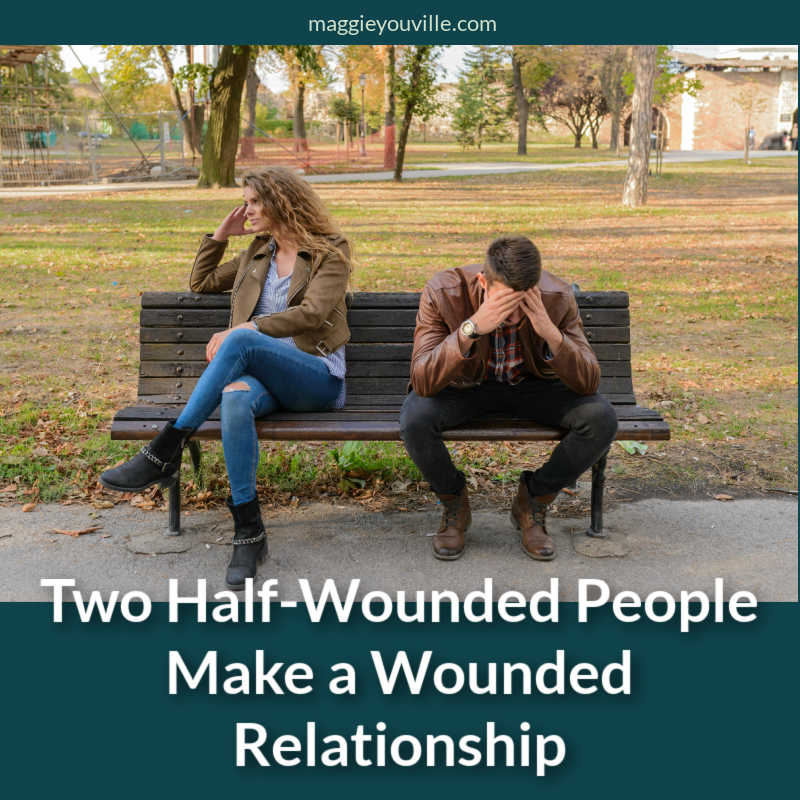
Wounded People Make a Wounded Relationship
“Two half-wounded people make a better whole,” Austin Mardon told The B.C. Catholic.
Mardon perpetuates the idea that I can expect marriage and a spouse to complete me or fix me or heal my broken parts or meet my needs. This is a common idea that’s not healthy or factual.
CatholicMatch.com explains why: “Before you can unite yourself to someone else as one, you have to be whole. Marriage is the union of one whole person plus another whole person, not one half of a person plus another half of a person, hoping to add up to one person. Therein lies the problem. We’ve got an awful lot of people who aren’t ready for marriage because they aren’t willing to work towards wholeness themselves. They hope someone else is going to fix them.”
Unfortunately, this is not a healthy perspective for entering marriage. If I expect my spouse to meet my deepest emotional needs, to heal my broken parts, I place an unrealistic expectation on him. He cannot help with any of that if I am not already working on healing myself and putting in the work required to address that need in myself.
Similarly, if I see those broken and hurting parts of him, and think that my love alone is enough to “fix” him, then I also set myself up for disappointment. If he is not willing to acknowledge those broken parts himself, and do his own work towards healing, then my love cannot help him.
Boundaries.me further explains, “When two incomplete people marry in hopes that merging their strengths will make up for each other’s weaknesses, the result is not the happiness they hope for. In fact, what happens is that each partner slowly comes to want from the other the things that that person does not possess.”
I saw this happen in my first relationship, as both my ex-husband and I brought our childhood wounds into our marriage and then constantly triggered each other. However, while I was willing to look back and acknowledge that my childhood trauma was causing issues in our relationship and I needed to seek counseling, he was not. Our needs for something the other didn’t have, and the way he treated me because of his wounds, eventually drove us apart.
The Mardons’ relationship is not successful because they are “two half-wounded people”; rather, it is successful because they are two people who are aware of their wounds and working towards healing and wholeness both personally and in their relationship.
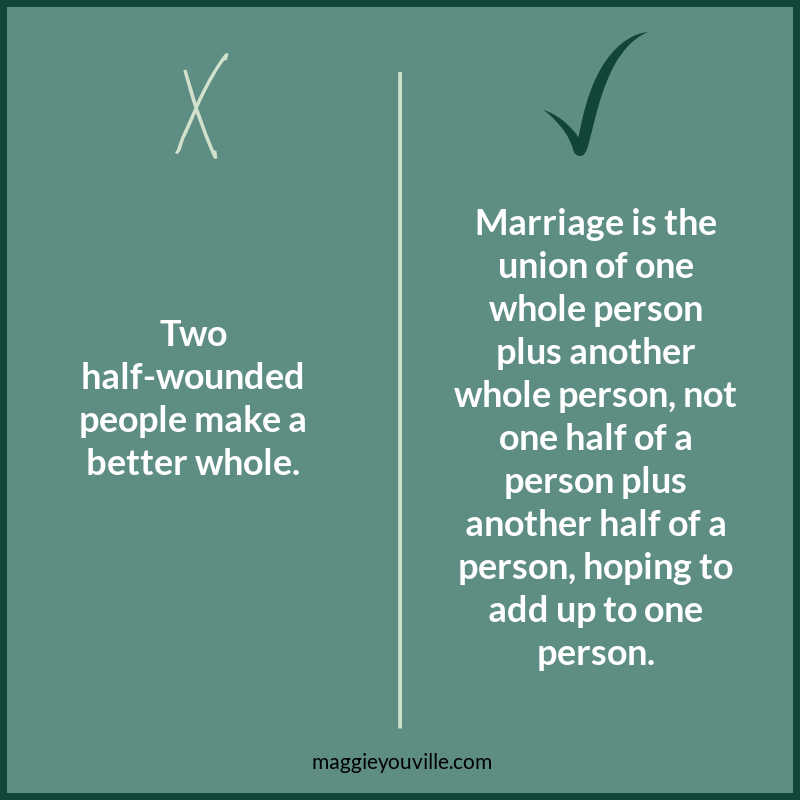
Mental Illness in Marriage
Because of their mental health conditions—Austin with his schizophrenia and Catherine managing the long-term effects of her traumatic brain injury—many doubted the couple’s intentions to marry. But when Austin had the courage to tell her about his diagnosis, Catherine recognized in him something rare. While many with the illness retreat from society, Austin remained committed to his treatment and to life. (emphasis added)
What makes Catherine’s and Austin’s marriage strong and healthy is that they are each honest about their needs, committed to their treatments, and taking care of themselves. They are not hiding or ignoring their diagnoses; they are not refusing medication and treatment; they are not blaming each other for the symptoms of their diagnoses.
In too many relationships between “two half-wounded people,” there is no honesty about the wounds. There is no managing of symptoms, no seeking of treatment, no acknowledgement of the harm of the wounds (whether that wound is past childhood trauma, mental illness, PTSD, neurodivergence, addiction, or something else). Holding up this couple as an example in this superficial way, without examining exactly what makes their relationship healthy, just perpetuates myths about marriage and keeps those in abusive relationships stuck.
Problem-Solving in Healthy Marriages
The key, Catherine says, is separating the person from the illness. “When symptoms break through, you deal with the problem—not the person.”
This is indeed a healthy way to view a spouse struggling with a particular diagnosis or wound. Each spouse is aware of the diagnosis (whether one spouse or both spouses have a diagnosis), how it affects the person diagnosed, and what helps with the symptoms of that diagnosis. The spouses need to have honest conversations about the diagnosis, its symptoms, its treatments, and more. Then they can be on the same page to say, “Hey, today _____ is happening because of my ______ and I need _____.”
In abusive relationships, however, the spouse with the wound is not willing to admit he has a problem. He won’t admit his symptoms are a problem. For example, a man with an addiction to alcohol may have erratic moods and behaviours, but if he won’t admit to his addiction and take steps to treat it, then his wife is left reeling from his moods and behaviours. Staying focused on his problems doesn’t really help her if he’s also unwilling to see and deal with those problems.
If the spouse with the diagnosis or illness does not have a plan to improve himself or manage his diagnosis or illness, then Catherine’s advice is a recipe for codependency. The undiagnosed or diagnosed and untreated spouse relies on his wife to manage his condition and its symptoms, and she feels needed and / or used by him but may also excuse his abusive behaviour as part of his diagnosis and worry about leaving him.
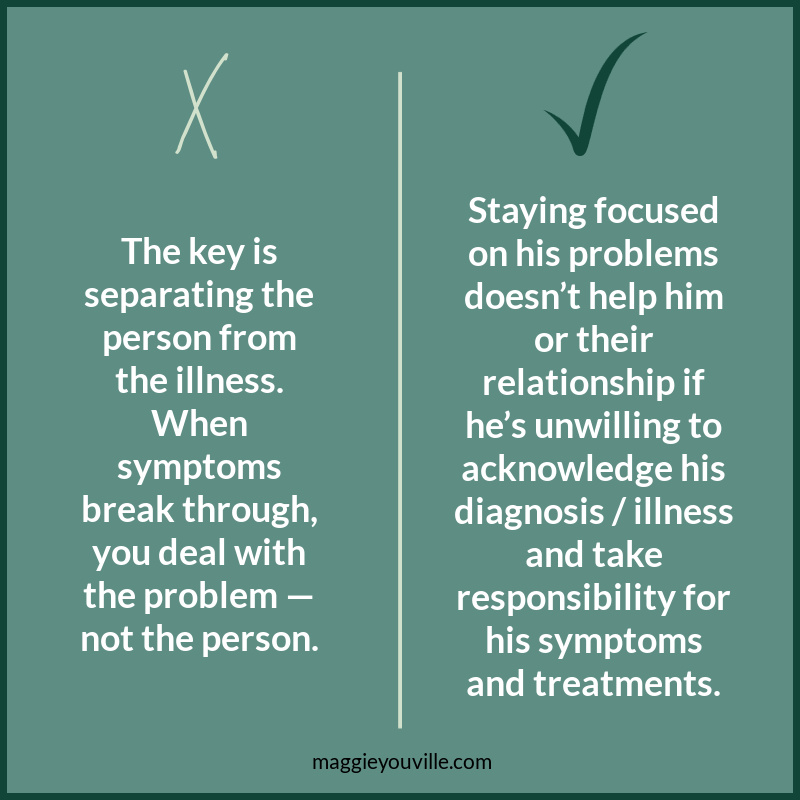
My ex-husband refused for many years to get diagnosed with sleep apnea, which greatly affected his entire life. He struggled to get up in the morning and often fell asleep in the middle of the day. Even when he was diagnosed, he refused to wear his CPAP. Instead, he expected me to be his alarm clock and got very angry at me if I couldn’t wake him up at the time he wanted. He also refused to do anything to prevent falling asleep during the day, and often dozed off in the middle of visits with family, while driving, or at Mass, creating huge embarrassment (and safety concerns) for me.
Finally, I realized that in helping with his problems by waking him up when necessary, never sleeping myself on road trips so I could make sure he wasn’t sleeping at the wheel, and either making excuses for him when he fell asleep visiting or trying to keep him awake, I was enabling him to ignore his own problems. I told him I would no longer be his alarm clock; if he was not willing to deal with his problems, I would not either.
This meant that on a couple of occasions, he overslept badly and missed a big meeting or appointment, and got verbally loud and abusive towards me. I had to let that go and calmly tell him again that I was not his alarm clock. His inability to wake up on time eventually caused his manager at work to speak to him about his tardiness, and then he began setting an alarm clock, and waking up not only on time but early, and getting himself to work.
When it mattered enough, he did deal with his problems – but as long as I was there to ease the problem, he didn’t deal with it. Nor did he start dealing with any other problems caused by his sleep apnea or even begin wearing his CPAP as recommended by his doctor. Catherine’s advice is thus dangerous for wives like me (who tried for years to “focus on the problem and not the person”), as it urges us to ignore another person’s sin and irresponsibility.
When Divorce is Not an Option
She also believes in commitment: “If you go in from the beginning without divorce as an option, you have to work through things.” As such, their relationship runs on communication and truth-telling.
If a couple has a relationship that runs on communication and truth-telling and working through problems, then divorce doesn’t need to be an option. However, telling every couple that divorce is not an option, without recognizing that there is a difference between two healthy people facing some problems in their relationship and one abusive person creating the problems in a relationship, enables abuse and makes the person giving advice complicit in that abuse.
In an abusive relationship, one party refuses to communicate, refuses to tell the truth, and refuses to work through things. In that case, divorce is the only option. Not allowing the victim to leave the relationship allows the abuser to keep abusing. This in turn perpetuates abuse, because children of abusers tend to become either victims or abusers themselves. If we want to stop divorce, we need to stop seeing divorce as the problem and see it as a symptom of a bigger problem, and then address that problem.
Catherine’s attitude ignores the fact that divorce and annulment are recognized within the Catholic Church for numerous reasons. An annulment “is a decision issued by the Catholic Church, through the marriage tribunal, that a marriage is invalid because something essential was absent at the time of the exchange of consent.” Massive issues within the marriage can indicate that this “something essential” was missing and the couple should consider whether they have grounds for divorce and annulment.
Dr. Tom Spudik says, “I am convinced that a happy marriage is highly unlikely until I get serious about changing/improving ME! … No matter how challenging or difficult my spouse may be, until I get serious about being a more loving spouse, I am unlikely to make much progress at all. To be sure, if a spouse is addicted to alcohol, is abusive, is mentally ill, etc. the other spouse is not to blame. I am not suggesting that we should take up responsibility for our spouse’s real character flaws. On the contrary, sometimes we need to speak up more assertively and in some cases a spouse may need to leave the situation.”
Catherine and Austin’s marriage is happy because they are each serious about improving themselves, as Dr. Spudik says. They were open and honest with each other about their disabilities and struggles before going into their marriage. They knew they’d face some ups and downs and difficulties and would need to stay committed to each other through that. However, that should not be generalized to everyone’s marriage struggles, because some marriage struggles are caused not by outside circumstances but by one spouse’s hardened heart. Dr. Sputnik’s caveat then applies: a spouse may need to leave the situation.
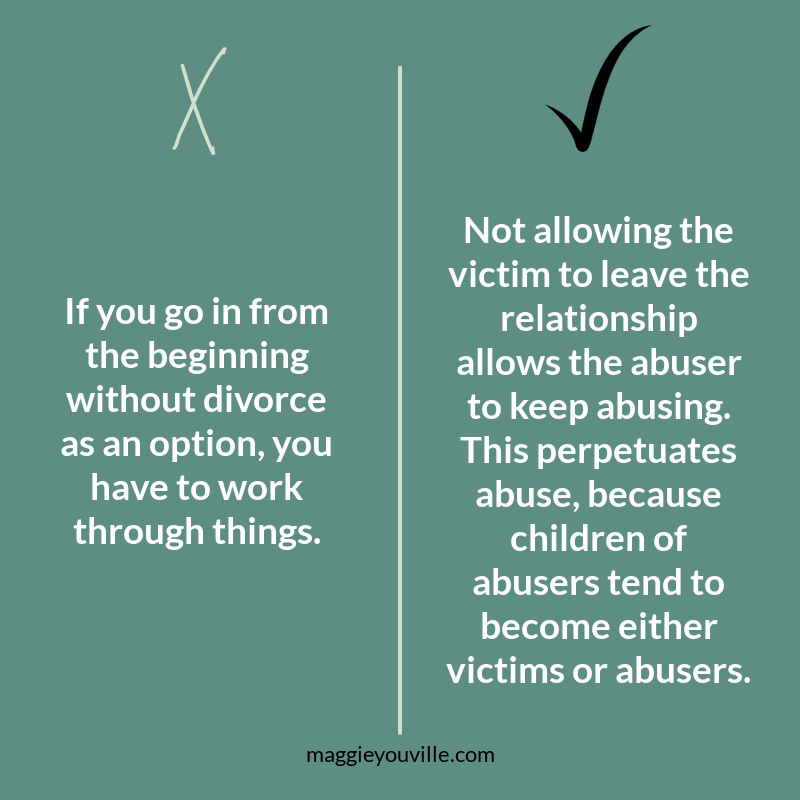
Complementing and Understanding Each Other
The pair complement each other well. Schizophrenia, which often affects a person’s ability to notice and understand social cues, sometimes works in Austin’s favour. He’s unflinching in situations that require difficult conversations or confrontation.
The pair complement each other well because they understand themselves and their diagnosis well, and their diagnoses help them to understand each other better. As stated above, their strengths cannot compensate for each other’s weaknesses, but their personalities and life experience can draw them together. Both of them clearly have similar goals, ambitions, interests, and passions in life. They also have similar disabilities. This gives them a lot of shared life experience on which to build a relationship.
I follow a single dad on Instagram. He often posts about his three children and how his wife’s death from cancer has affected all of them. As I read his posts about how much they miss her and what a beautiful, loving legacy she left behind, I wondered if I could be in a relationship with someone like that. His memories of his past partner are treasured and wonderful; my memories of my past partner are painful and traumatic.
When I met my current partner, we initially thought we were too different to even be friends, but we were both escaping abusive relationships. Our first conversations together were about dealing with that abuse and trying to find healing. While I’ve often wished we didn’t have those past painful memories to deal with, I’m also grateful that because of our past experiences, we deeply understand each other and the pain we’ve each been through. My ex-husband brushed off my attempts to tell him about how my dad abused me; my current partner listens when I share my hurt, understands the abuse I endured, and takes care of me.
In Austin’s and Catherine’s relationship, I see a similar bond between them because of their wounds, rather than in spite of their wounds. No, we can’t expect our spouse to heal us. However, it is deeply healing to be seen and heard by someone who truly understands us and what we have been through, whether that person is a spouse, a priest, a good friend, a therapist, or a saint whose story mirrors ours. Often, the people who understand us best are the people who have shared some of our experiences.
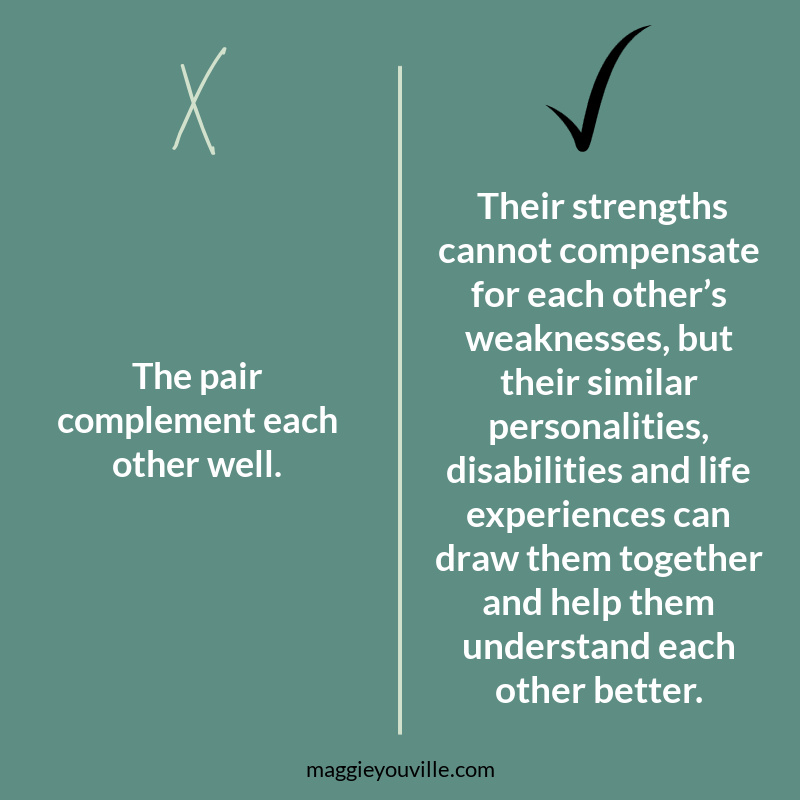
In Conclusion
Couples like Catherine and Austin do offer wonderful examples for other couples. However, a more nuanced look at what works in their relationship is required. Too many people in a healthy relationship take that relationship for granted, and think what they do will work for anyone else. This is not true.
For Catherine and Austin, divorce is not an option because they DO have a great relationship and they can talk to each other about any issues that come up between them. However, generalizing that advice to all marriages without pointing out that it takes TWO people to make a marriage work, as is clearly shown in Catherine’s and Austin’s relationship, is not okay.
If Catherine had married a narcissist who brushed off her symptoms of traumatic brain injury as attention seeking, and told her to just do better, and refused to support her work as a lawyer and advocate, then she wouldn’t be where she is today. (Of course, he wouldn’t have acted like that when they were dating. He would have been sympathetic to her and pretended to admire her for her ambitions, and later he would subtly begin to undermine both.)
If Austin had married someone who didn’t think schizophrenia was a real diagnosis, and wondered why he needed to spend money on treatments, and complained about his travel, then he also wouldn’t be where he is today. They are both blessed to have supportive, understanding spouses, but also exceptionally lucky to have found each other.
The BC Catholic editors and writer may argue that this article wasn’t written for spouses in abusive relationships. However, their article also doesn’t contain any disclaimers saying so. The reality is that 1 in 4 women are dealing with abuse, so at least a quarter of the newspaper’s readership may be in abusive relationships. They may not recognize this abuse themselves, which makes the conclusions drawn in this article even more dangerous. And those women who are dealing with abuse likely all have a friend who will read this article and, not knowing anything about their friend’s situation or abuse, parrot this advice to them and further the victim’s feeling of helplessness, confusion, and isolation.
If you have a healthy, happy relationship, please do not take it for granted and do not assume that what has made your relationship work will help another couple. If a friend comes to you for marriage advice, listen more than you speak. Give advice sparingly. Learn about domestic violence and its signs and if you have any concerns, encourage your friend to seek professional help.
If you are in a confusing, painful relationship, there is help. Please see the recommended resources and try to find a counselor who has experience in domestic violence and trauma. You are not alone; you do not have to put up with misery in your relationship.
If you have a platform as a writer, priest, influencer, or speaker, please consider carefully what advice you give to married couples. Will this advice harm someone in a toxic or destructive relationship? I too have shared advice based on “this worked for me,” but I now think we also need to say “but it might not work for you if your situation is different than mine.” Please be willing to listen to feedback from your audience, especially if someone says, “What you said hurt me,” and to learn about domestic violence and abuse so you can avoid enabling or encouraging it.
Leave a Reply